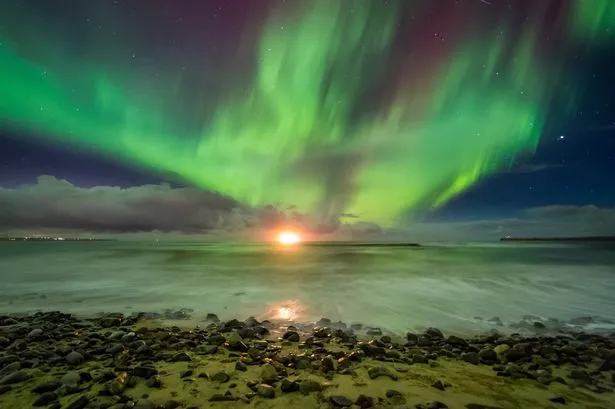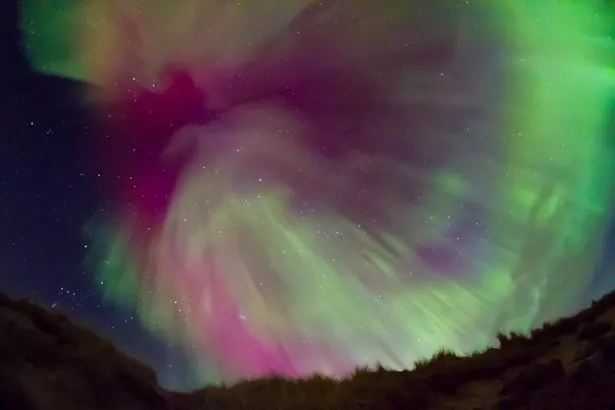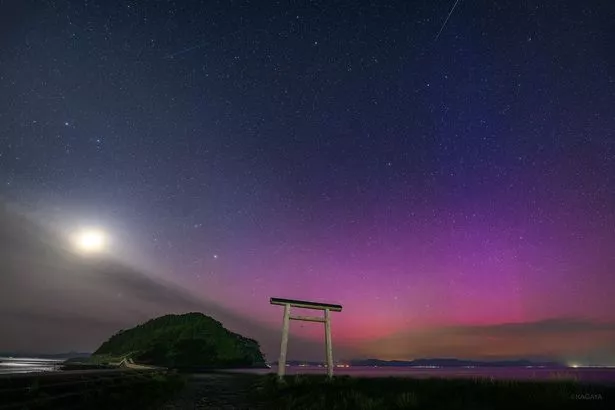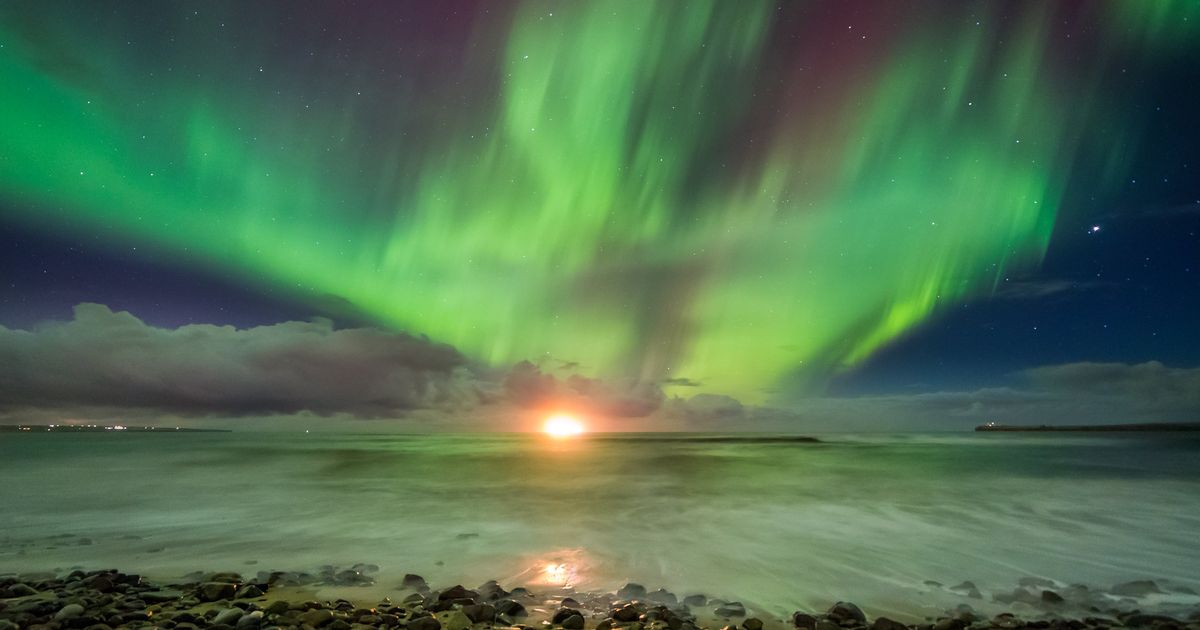NASA scientists are still making huge discoveries about the largest geomagnetic storm to hit Earth in two decadesThis article contains affiliate links, we will receive a commission on any sales we generate from it. Learn more Stargazers across the UK were treated to a Northern Lights display in April courtesy of a geomagnetic storm(Image: SWNS)
Stargazers across the UK were treated to a Northern Lights display in April courtesy of a geomagnetic storm(Image: SWNS)
Scotland is one of a few select countries lucky enough to pretty regularly host the Northern Lights. From rural spots unspoiled by light pollution to city gardens, Scots have managed a glimpse of the phenomenon from everywhere.
In April, Brits were left mesmerised after witnessing the dazzling Aurora Borealis gracing the night sky. Stunning snapshots of the luminescent aurora borealis filled social media, captured by stargazers all over the UK.
Prime conditions were forecasted by the Met Office, meaning even those in southern England had an opportunity to see the geomagnetic spectacle. Many parts of Scotland, as usual, were treated to stunning overhead views.
This Northern Lights display arrived in Scotland as a result of a geomagnetic storm.
And now, NASA has confirmed that a storm that occurred last year, similar to what brought the Northern Lights spectacle to Scotland a couple of months ago and will continue to trigger more, was the biggest in 20 years.
 Amazing aurora burst over the hills in Caithness, Scotland(Image: SWNS)
Amazing aurora burst over the hills in Caithness, Scotland(Image: SWNS)
A geomagnetic storm is a large disturbance in the Earth’s magnetic field triggered by powerful coronal mass ejections that create the Northern Lights.
Geomagnetic storms are caused by changes in the solar wind and interplanetary magnetic field (IMF) structure. These changes in the solar wind arise from disturbances on the sun, such as in CMEs.
Their effect can be felt for a number of days. With the right magnetic configuration, and increases in solar wind speed and density, large amounts of energy can be transferred into the Earth’s geomagnetic system.
 Join the Daily Record WhatsApp community!
Join the Daily Record WhatsApp community!
Get the latest news sent straight to your messages by joining our WhatsApp community today.
You’ll receive daily updates on breaking news as well as the top headlines across Scotland.
No one will be able to see who is signed up and no one can send messages except the Daily Record team.
All you have to do is click here if you’re on mobile, select ‘Join Community’ and you’re in!
If you’re on a desktop, simply scan the QR code above with your phone and click ‘Join Community’.
We also treat our community members to special offers, promotions, and adverts from us and our partners. If you don’t like our community, you can check out any time you like.
To leave our community click on the name at the top of your screen and choose ‘exit group’.
If you’re curious, you can read our Privacy Notice.
And one year on, NASA scientists are still making huge discoveries about the largest geomagnetic storm to hit Earth in two decades, the Gannon storm.
On May 10, 2024, the first G5 or “severe” geomagnetic storm in over two decades hit Earth. The event did not cause any catastrophic damages, but it did produce surprising effects on Earth.
The storm, which has been called the best-documented geomagnetic storm in history, spread auroras to unusually low latitudes and produced effects spanning from the ground to near-Earth space.
“Data captured during this historic event will be analysed for years to come, revealing new lessons about the nature of geomagnetic storms and how best to weather them,” a NASA spokesperson said.
What was the fallout of the storm?
The Gannon storm had effects on and off our planet. On the ground, some high-voltage lines tripped, transformers overheated, and GPS-guided tractors veered off-course in the Midwestern US.
In the air, trans-Atlantic flights were forced to change course due to the threat of higher radiation exposure, as well as communication and navigation losses.
During the storm, Earth’s upper atmospheric layer, the thermosphere, heated to unusually high temperatures. At 100 miles altitude, the temperature typically peaks at 1,200 degrees Fahrenheit, but surpassed 2,100 degrees Fahrenheit.
In orbit, the expanded atmosphere increased drag on thousands of satellites. The European Space Agency’s Sentinel mission required more power to maintain their orbits and perform manoeuvres to avoid collisions with space debris.
The storm also dramatically changed the structure of an atmospheric layer called the ionosphere. A dense zone of the ionosphere that normally covers the equator at night dipped toward the South Pole in a check mark shape.
This caused a temporary gap near the equator.
How were the Northern Lights impacted? In Japan, where it’s typical to see red auroras, numerous sky watchers captured photos of unusual magenta auroras(Image: KAGAYA)
In Japan, where it’s typical to see red auroras, numerous sky watchers captured photos of unusual magenta auroras(Image: KAGAYA)
The storm ignited auroras around the globe, including places where these celestial light shows are rare. In fact, NASA was inundated with more than 6,000 observer reports from over 55 countries and all seven continents.
Auroras seen throughout Japan were magenta rather than the typical red and the auroras were surprisingly high – around 600 miles above the ground (200 miles higher than red auroras typically appear).
Josh Pettit of NASA’s Goddard Space Flight Center said Japan’s magenta auroras were “a very unique event indeed.”
More to come for Scotland?
The Met Office space weather channel currently shows no Northern Lights activity in Scotland.
However, looking ahead, the national forecaster gives some hope for Scots towards the end of the week.
“The next stream of faster solar wind may give some minor enhancement to the auroral oval through May 15 and 16,” the Met Office said.
“This perhaps giving an increased chance of the aurora becoming visible down to northern Scotland and similar geomagnetic latitudes, where viewing conditions allow.”
